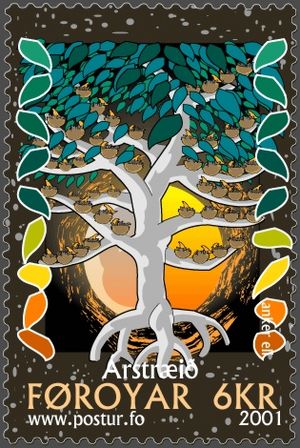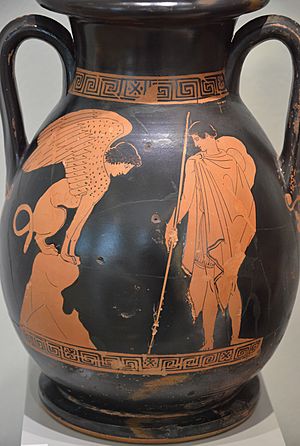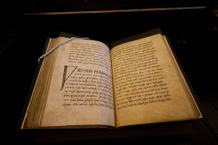Riddle facts for kids
A riddle is a clever statement, question, or phrase that has a hidden meaning. It's like a puzzle you need to solve! Riddles come in two main types:
- Enigmas are problems that use metaphors or symbolic language. They need smart thinking to figure out.
- Conundra are questions that use wordplay or puns in either the question or the answer.
People all over the world use riddles. Experts like Archer Taylor say that riddles are a "universal art." You can find riddles in hundreds of different cultures, from Finland to the Philippines. Many riddles and their themes are known in many countries.
Elli Köngäs-Maranda, who studied riddles from Malaita, said that myths help set social rules. But riddles "play with ideas and cross boundaries." They show that things aren't always as simple as they seem.
Contents
What Are Riddles?
Where the Word "Riddle" Comes From
The word "riddle" comes from an old Germanic verb, *rēdaną. This word meant 'to interpret' or 'to guess'. From this, we got the Old English word *rǣdels, which became our modern English word "riddle."
How Experts Define Riddles
It's tricky to define riddles exactly, and scholars have debated it a lot. In 1963, Robert A. Georges and Alan Dundes suggested that "a riddle is a traditional verbal expression." It has clues, and you have to guess what they refer to. Some types of riddles include charades and certain jokes.
Sometimes, riddles can be like proverbs. For example, a Russian phrase means "Nothing hurts it, but it groans all the time." If it's about a person who always complains, it's a proverb. If it's about a pig, it's a riddle!
How People Study Riddles
Much of the study of riddles has been about collecting them, putting them into groups, and defining them. Important work was done by Antti Aarne and Archer Taylor. For old riddles without answers, scholars try to figure out what the solutions might be.
In the past, researchers often looked at riddles by themselves. But after World War II, people started studying riddles in their social settings. They saw how riddles helped people deal with fear and worry. However, most big studies have focused on Western riddles, with less attention on Asian and African ones.
Linguists also study riddles to see how language works. More recently, people have looked at medieval European riddles to learn about how people thought about their environment.
Riddles From Around the World
Many riddles are found in similar forms across different countries and even continents. Riddles can travel short distances or very long ones. For example, a riddle from the Ewe language was borrowed by Logba speakers: "This woman has not been to the riverside for water, but there is water in her tank." The answer is "a coconut."
The famous Riddle of the Sphinx has even been found in the Marshall Islands! This might have happened because of contact with Westerners.
Here are some examples of riddles found in many places, based on a study by Antti Aarne:
The Writing Riddle
The basic idea of the writing riddle is 'White field, black seeds'. The "field" is a page, and the "seeds" are letters. Here's an old example from the 8th or 9th century:
|
Se pareba boves |
In front of him (he) led oxen |
In this riddle, the "oxen" are the scribe's fingers and thumb. The "plough" is the pen. Riddles about pens and writing tools are very common in literature.
The Year Riddle
The year riddle is found all across Europe and Asia. For example, an old Sanskrit riddle from about 1500–1000 BCE describes a 'twelve-spoked wheel, upon which stand 720 sons of one birth'. This means the twelve months of the year, which together have 360 days and 360 nights.
The Person Riddle
The most famous example is the riddle of the Sphinx. Here's an Estonian example:
|
Hommikul käib nelja, |
It goes in the morning on four feet, |
This riddle describes a baby crawling (four feet), a person standing (two feet), and an old person with a walking stick (three feet).
Two-legs, Three-legs, and Four-legs
This type of riddle includes examples like this German one:
|
Zweibein sass auf Dreibein und ass Einbein. |
Two-legs sat on Three-legs and ate One-leg. |
The answer is: Two-legs is a person, Three-legs is a three-legged stool, Four-legs is a dog, and One-leg is a ham hock.
Four Hang; Two Point the Way
A common answer to this riddle is 'cow'. Here's an Icelandic version from the 13th century:
|
Fjórir hanga, |
Four are hanging, |
The cow has four teats (hanging), four legs (walking), two horns (point the way), two back legs (ward the dogs off), and one tail (dangles behind).
The Featherless Bird Riddle
This riddle is well-known in Central Europe. Here's an English version:
White bird featherless
Flew from Paradise,
Perched upon the castle wall;
Up came Lord John landless,
Took it up handless,
And rode away horseless to the King's white hall.
The answer is a snowflake. It falls from the sky ("Paradise"), lands on a wall, and then the wind ("Lord John landless") blows it away.
Riddle Traditions by Region
Riddles were a popular type of writing in ancient and medieval times. We find many riddles in old written records. More recently, scholars have collected riddles from people who tell them as part of their oral traditions around the world.
Babylon
The oldest riddles we know of come from ancient Babylon. They were found in school texts. We don't have the answers to these riddles. One example is: "my knees hasten, my feet do not rest, a shepherd without pity drives me to pasture" (maybe a river or a rowboat?). These might have been riddles from everyday life that teachers put into school books.
South Asia
The oldest surviving poetic riddles are thought to be in the Sanskrit Rigveda, an ancient Indian text. Hymn 164 of the first book of the Rigveda has a series of riddles. These riddles are now hard to understand, but they might have been about a special ritual.
Riddles also appear in other ancient Indian texts. One example is: "Who moves in the air? Who makes a noise on seeing a thief? Who is the enemy of lotuses? Who is the climax of fury?" The answers to the first three questions combine to give the answer to the fourth. The answers are bird (vi), dog (śvā), and sun (mitra). Put together, they spell Vishvamitra, a wise man known for his anger.
Later, riddles were included in early stories like the Mahabharata. This epic contains the Yaksha Prashna, where a nature spirit asks riddles to a hero named Yudhishthira.
Hebrew, Arabic, and Persian
Riddles are not very common in the Bible, but they do appear. The most famous is Samson's riddle in the Book of Judges. The Queen of Sheba also tested King Solomon with riddles.
In the Middle Ages, riddles became an important type of literature in the Arabic-speaking world, and in Islamic Persian and Hebrew cultures. This was especially true in Spain (Al-Andalus). Old Arabic and Persian poetry often used rich, descriptive language. This made it easy for riddles to fit in with their poetry style.
Riddles were found in poetry collections and in stories about riddle contests. Over time, riddles in Arabic and Persian became more academic. They often focused on puzzles where you had to figure out letters and numbers to find the answer.
Europe
Greek Riddles
Riddles were popular in ancient Greece, especially at parties called symposia. Oracles, who gave prophecies, often spoke in riddle-like language. The main collection of ancient Greek riddles is in the Greek Anthology, which has about 50 verse riddles. Most surviving ancient Greek riddles are in poetry. The philosopher Aristotle said that "good riddles do, in general, provide us with satisfactory metaphors."
Latin and Romance Riddles
Two Latin riddles are found as graffiti in the Basilica at Pompeii. The most important collection of ancient Latin riddles is by Symphosius. He wrote 100 riddles that influenced later writers. These riddles were also important in medieval Spanish traditions.
The Veronese Riddle, from the 8th or 9th century, is a key example of how Latin changed into Romance languages. However, riddles are rare in medieval Romance languages. In later times, printed riddle collections became popular in French.
Germanic-Speaking World
Only a few riddles survive from Old High German. About 150 riddles are found in Middle High German, usually as quotes in other writings. Riddles are also rare in Old Norse. Almost all of them are in one section of Hervarar saga ok Heiðreks, where the god Óðinn asks about 37 riddles. These riddles tell us about Norse mythology and old Scandinavian customs.
When printing began in the West, many riddle collections were published in German-speaking areas and Scandinavia. Riddles were very popular in Germany. One famous riddle from that time is:
|
Es kam ein Vogel federlos, |
There came a bird featherless |
This riddle means: "the snow (featherless bird) lies on a bare tree in winter (leafless tree), and the sun (speechless maiden) causes the snow to melt (ate the featherless bird)."
English speakers also published riddle collections. For example, the 1598 Riddles of Heraclitus and Democritus includes:
First I was small, and round like a pearl;
Then long and slender, as brave as an earl;
Since, like an hermit, I lived in a cell,
And now, like a rogue, in the wide world I dwell.
After the early Middle Ages, riddles were not often used as a serious literary form in English. Today, English riddles often use puns for humor, rather than to truly puzzle someone. For example: "Why is six afraid of seven?" "Because seven eight nine (ate nine)." These are mostly children's jokes now.
Some riddles play on similar sounds in different languages:
- There were two cats, 1 2 3 cat and un deux trois cat, they had a swimming race from England to France. Who won?
- 1 2 3 Cat because Un deux trois quatre cinq (un deux trois cat sank)
This riddle uses the French words for 'four' and 'five', which sound like "cat" and "sank" in English.
Celtic-Speaking World
Few riddles are found in medieval Celtic languages. However, some old Welsh and Irish legal texts might be seen as riddles. One clear Welsh riddle is 'Canu y Gwynt' ('song of the wind'). It's about the wind and was probably inspired by Latin riddles.
The earliest Irish riddles are from the 15th century. Other wisdom contests appear in Irish literature, where riddles might be asked.
Finnic-Speaking World
Traditional riddles from the Finnic-speaking world (like Finland and Estonia) are quite similar. The Finnish word for "riddle" is arvoitus, which is related to the verb arvata ("guess"). Riddles are some of the first examples of Finnish literature we have.
East Asia
China
In Chinese, the word for 'riddle' is mi (謎), meaning "to bewilder." Riddles have a mian (面, "surface," the question) and a di (底, "base," the answer). Old Chinese words for 'riddle' meant "hidden."
Literary riddles in China started appearing in large numbers around the 2nd century CE. Chinese riddles often use visual puns on Chinese characters. For example, the riddle "千 里 会 千 金" means 'thousand kilometre meet thousand gold'.
- To solve it, first you think about the words:
- "千 里" (thousand kilometer) can mean "马" (horse), because a good horse can run thousands of kilometers a day.
- "千 金" (thousand gold) can mean "女" (daughter), because a daughter is very important.
- Then, you combine the characters visually: putting "马" (horse) with "女" (daughter) creates the character "妈" (mother).
So the answer to the riddle is "妈" (mother).
Riddles have long been an important part of the Chinese Lantern Festival. China also has a special kind of riddle called a kōan. These were used in Zen Buddhism to help people reach enlightenment through meditation.
The Philippines
In the Philippines, a riddle is called Bugtong. It's often used during funeral wakes, along with other games. Later, Bugtong became a fun pastime. Filipino riddles often start with the phrase Bugtong-bugtong and usually rhyme.
Here's a Tagalog Bugtong:
|
Bugtong-bugtong, Hindi hari, hindi pari |
Riddle-riddle, not a king, nor a priest, |
| —Sampayan | —Clothes line |
Africa
Researchers have collected many riddles from Africa. Riddles are seen as "one of the most important forms of oral art in Africa." Scholars study how riddles are performed and what they mean in society. Some see African riddles as a way to understand African philosophy.
The Americas
Native American Traditions
For a long time, people thought Native American cultures didn't have their own riddle traditions. They thought any riddles were inspired by European culture. But in the 20th century, more Native American riddles were collected. For example, in 1639, Hieronymus Lalemant described a riddle contest among the Huron people.
One Huron riddle was: "What I desire and what I am seeking is that which bears a lake within itself." The answer was a pumpkin or calabash. Another was: "What I ask for is seen in my eyes—it will be marked with various colors." Since the Huron word for "eye" also meant "glass bead," the answer was glass beads. This shows that riddles did exist in the Americas before European influence.
Colonial Traditions
Riddles are also common in the settler cultures of the Americas.
One type of riddle is found in payada de contrapunto in Argentina and Uruguay. This is a musical style where guitar players challenge each other with riddle-like questions and answers. They sing back and forth, sometimes with jokes or playful insults.
Riddle Contests
A Riddle Game is a formal contest of cleverness. Players take turns asking riddles. The player who can't answer loses. Riddle games often appear in myths, folklore, and popular stories.
It's important to know that in many cultures, people aren't always expected to guess the answers to riddles. Sometimes, the riddler tells the answer, or people learn riddles and their answers as they grow up. So, riddle contests are not the only way riddles are used.
A "neck-riddle" is an unsolvable riddle that a character uses to win a contest.
Riddle Contests in Real Life
In ancient Greece, riddle competitions were popular at parties. Elias Lönnrot observed riddle contests in 19th-century Finland. In these games, one person would leave the room, and the others would agree on a riddle. If the person couldn't guess the answer three times, they had to leave the game.
Riddle Contests in Old Stories
In old stories, riddle contests often create the main plot. These contests are a type of wisdom contest. They usually involve testing a king's wisdom or a suitor's suitability for marriage.
Riddle Contests in Modern Stories
- In J. R. R. Tolkien's The Hobbit, Gollum challenges Bilbo Baggins to a riddle competition for his life. Bilbo wins, even though he breaks the rules a little.
- In The Grey King by Susan Cooper, Will and Bran must win a riddle game to claim Bran's heritage.
- In Patricia A. McKillip's The Riddle-Master trilogy, riddles are a way of recording history and guiding life. The main character, Morgon, starts his journey by winning a riddle game.
- In Stephen King's The Dark Tower III: The Waste Lands and The Dark Tower IV: Wizard and Glass, the heroes must riddle against a train named Blaine the Mono to save their lives. One hero, Eddie Dean, wins by asking joke riddles, which confuse Blaine's logical mind.
- In the Batman comic books, one of Batman's enemies is The Riddler. He loves to leave clues about his crimes in the form of riddles and puzzles.
See also
 In Spanish: Adivinanza para niños
In Spanish: Adivinanza para niños
- Charades
- Dilemma story
- Droodles
- Missing dollar riddle
- Neck riddle
- Newspaper riddle
- Oedipus and the Sphinx
- Riddle joke
- Riddles (Anglo-Saxon)
- Riddles (Arabic)
- Riddles (Chinese)
- Riddles (Finnic)
- Riddles (Greek)
- Riddles (Hebrew)
- Riddles (Persian)
- Rumpelstiltskin




